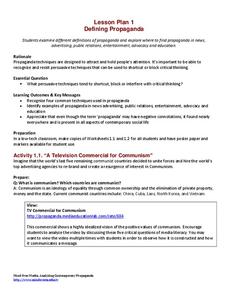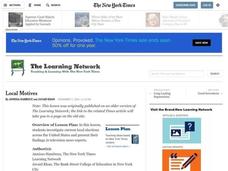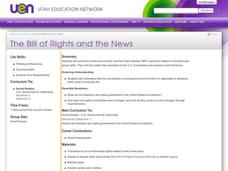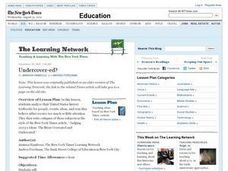Curated OER
Creating a Newscast on the Cold War
Learners research the events of a specific year of the Cold War. In this Cold War lesson, students investigate the causes of the Cold War and highlight the events of a particular year. Learners create a...
Curated OER
And Now, the News from Iraq
Students consider the challenges facing Iraqi voters and various attitudes toward the election. They research topics related to the January 2005 election, then write segments for a television news hour.
Curated OER
Community of Interests
Young scholars evaluate various aspects of community through local and national news. They explore the different sections of a newspaper and how each relates to a different aspect of a community.
Curated OER
The Penny Press, Walt Whitman and the War
Students examine the Penny Press and how it began the era of mass circulated newspapers. They use the internet to research the writing style of the paper and write a short article using that style.
Curated OER
What's The Big Deal?
Fifth graders examine the role of the Gutenberg press and its effect on society. Using this information, they write a persuasive paper discussing which form of copying is easier to mass produce. They share their opinions with the class...
Media Education Lab
Defining Propaganda
21st century learners live in a media world. Help them develop the skills they need to be able to analyze the barrage of propaganda they face daily, with a resource that introduces them to the type of persuasive appeals found in...
Curated OER
Stop the Fighting and Start Uniting
Research current and proposed peace talks around the world with this New York Times lesson, Using the Darfur peace talks in Abuja, Nigeria as a starting point, middle schoolers create a news program on the subject. They propose a future...
Curated OER
Nellie Bly's Newspaper Club: Introducing the Art of Writing
Students use video and the Internet to research the life of Nellie Bly, a famous female reporter from the 19th century. They research a writer and present their information to the class in the style of a news reporter.
Curated OER
Local Motives
Investigate current local elections across the United States with this New York Times reading lesson. Using informational text, middle and high schoolers research local elections and create their own news reports about what they...
Curated OER
Islamic Faith and Discrimination
After the events on 9/11 many Muslim-Americans experienced discrimination because of their ethnicity and faith. Help break the cycle of ignorance by educating your students on the history, religion, and beliefs of a different culture....
Curated OER
Careers in Television
Students discuss and research how a news program is produced. They watch a web based video before working in small groups to produce a news program. They role play different jobs as they produce the program to share with at least one...
Curated OER
Who, What, When, Where, Why, and the Media
Students in a preschool classroom discuss potentially fearful current events in a way they can understand. They write or draw about a current event, discussing the 5 W's of news reporting.
Curated OER
What Weather When and Where?
Students learn the difference between hard news and feature writing. They choose one of these news styles to write a compelling weather-related article based on interviews with local sources.
Curated OER
Mixing Metaphors with Politics
Learners discuss different literary devices and use them to write summaries of New York Times articles dealing with international news. They reflect on the effectiveness and appropriateness of sports metaphors in the political arena.
Curated OER
The Bill of Rights and the News
Students examine current news stories and from them develop "BIG" questions related to individual and group rights. They then relate their questions to the U.S. Constitution and supreme court decisions.
National Center for Case Study Teaching in Science
Cell Phone Use and Cancer
The cell phone you're using is making you deaf: news at 11:00. Oftentimes, the media uses fear tactics and other techniques to increase its audience base. In an intriguing look at the difference between scientific journals and...
Media Smarts
Looking at Newspapers: Introduction
A scavenger hunt introduces class groups to the different sections of newspapers and the different types of articles found in each section.
Curated OER
Budget Busters
Use this economic activity to focus on writing summaries of informational text. First, middle schoolers define common economic terms used to describe news about the economy. They closely read news about the federal budget deficit and...
Curated OER
Undercover-ed
Have your class engage in critical-thinking activities using this resource. Learners discuss a variety of topics they think get too much, or too little, attention from the press. They analyze why these topics are over or underrated....
Curated OER
Music Advocacy
Students view part of a video about advocating for music education. They discuss the importance of supporting music education in schools and create a presentation for the PTO, a news release about a local music event and/or scripts for a...
Curated OER
News From Home
Students investigate the feelings of Iranian immigrants in California by reading an online article. They write an article on immigrants' thoughts on current events in their home countries.
Curated OER
Will the Supreme Court Vouch for Vouchers?
Students investigate past Supreme Court decisions that have centered on education issues and assess the ways in which those decisions have impacted American education. They consider the controversies surrounding the issue of school...
Curated OER
Leaf Prints
Creating art from nature teaches learners how to appreciate the world around them while allowing them to practice artistic techniques. After observing and choosing fall leaves from outside, they create leaf prints. They press the painted...
Curated OER
How Did We Arrive at the Printed Book?
Seventh graders, in cooperative learning groups, research the development of book printing. After examining a story written on a scroll, an accordion book, and a printed copy, they evaluate them according to a certain criteria and...

























